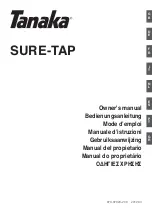
15
9.5 Blade Replacement
The use of worn blades decreases the effectiveness of
the cutter and can also side load the cylinder, possibly
damaging the tool. Pump overheating may also occur.
Replace blades immediately when it is noticed that
they are worn and/or damaged, or if there has been a
noticeable decrease in cutting performance.
The cutter contains a fixed blade and a moving blade.
Refer to Section 9.5.1 for fixed blade replacement
instructions and to Section 9.5.2 for moving blade
replacement procedures.
NOTICE:
CAUTION
Use extreme caution when removing
and installing blades. Blades may be sharp even
when worn. To avoid hand injury, wear appropriate
hand protection and avoid contact with blade cutting
edges.
NOTICE
To help ensure even blade wear and optimum
cutting performance, it is recommended that both the
fixed blade and the moving blade be replaced at the
same time.
9.5.1 Fixed Blade Replacement
Replace the fixed blade as described in the following
steps. Refer to Figure 12.
1. Start the pump. Move the piston to the “home”
position (fully retracted). See Figure 8.
2. Stop the pump. Be sure that hydraulic pressure is
completely relieved.
3. Disconnect pump from AC power supply.
NOTICE:
WARNING
Always disconnect pump from AC
power supply before beginning cutter blade
replacement procedures. Failure to observe this
precaution could result in accidental startup as
procedures are being performed. Serious personal
injury could result.
4. Place the cutter horizontally on a stable work surface.
5. Open the cutting head. Refer to Section 7.2 for
additional information.
6. Remove retaining ring (Figure 12, item 1B). Remove
clevis pin (Figure 12, item 5) and cutting head
(Figure 12, items 6-14).
7.
For model EWCH90, remove nine capscrews
(Figure 12, item 6), washers (Figure 12, item 13)
and nuts (Figure 12, item 14). For model EWCH140,
remove six socket head screws, washers and nuts.
8. Separate left side outer plate (Figure 12, item 9), inner
plate (Figure 12, item 11) and right side outer plate
(Figure 12, item 12).
9. For model EWCH90, remove eight fixed blade
screws (Figure 12, item 7) and washers (Figure 12,
item 8) and remove fixed blade (Figure 12, item 10). For
model EWCH140 remove seven fixed blade screws
and washers and remove blade.
10. For model EWCH90, install new fixed blade
(Figure 12, item 10) onto left side outer plate
(Figure 12, item 9) with eight fixed blade screws
(Figure 12, item 7) and lock washers (Figure 12,
item 8) and torque to 91 in-lb [10 Nm]. Also apply
Loctite 243 or equivalent.
11. For model EWCH140, install new fixed blade
(Figure 12, item 10) onto left side outer plate
(Figure 12, item 9) with seven fixed blade screws
(Figure 12, item 7) and lock washers (Figure 12,
item 8) and torque to 18 ft-lb [25 Nm]. Also apply
Loctite 243 or equivalent.
12. Assemble the left side outer plate (Figure 12, item 9),
inner plate (Figure 12, item 11) and right side outer
plate (Figure 12, item 12) using nine capscrews
(Figure 12, item 6), washers (Figure 12, item 13)
and nuts (Figure 12, item 14) for model EWCH90
and six socket screws, washers and nuts for
model EWCH140. Torque to 155 ft-lb [211 Nm]. Also
apply Loctite 243 or equivalent.
13. Attach cutting head (Figure 12, items 6-14) to
tool body using clevis pin (Figure 12, item 5) and
retaining ring (Figure 12, item 1B).
14. Close the cutting head. Refer to Section 7.2 for
additional information.
15. Test for proper operation before placing the cutter
back into service.
Summary of Contents for EWCH140
Page 19: ...Notes ...
Page 20: ...WWW ENERPAC COM ...






































